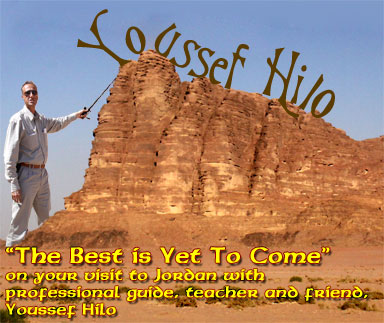A Tour Experience to Remember
Here is a new note of information based on a few visitor requests over the last two years during occasional times of political events of some uncertainty. The irony for us in Jordan has been the solidarity and safety provided by Highness King Abdullah, during those same periods of what seem to be unrest in other nearby countries. It's just too good a story to not tell, because it describes such as wonderful story about the leadership spirit of Jordan, specifically His Highness King Abdullah bin Al-Hussein and how his leadership sets an example for every Jordanian to personally welcome and assist every person who wants to visit our wonderful and historic nation, regardless of the time of year or condition of weather. In December 2013, Jordan and many of its neighbors was hard hit by snow storms that slowed traffic, caused accidents, delayed schooling and interfered with travel to and through or country on business and tourism (but not too much swimming.) A number of Amman's city streets became blocked; traffic was bogged down. Among those blocked from making progress was his Highness, King Abdullah II, at a standstill because vehicles in front of his were stuck in the snow. A good leader does not just sit on his throne, in his car or palace, and merely shout commands. A great leader sets examples by personally getting out into the fray and showing others how to solve the problem, which is exactly what King Abdullah proceeded to do. Here is the video showing what happened, with a great headline in the UK Daily Mail of Jordanians personally speaking with the King asking for help, unafraid to approach him with their problem: "Your Highness, can you give us a push?" Next thing to see on the video below is our beloved King "giving a push" out of the snow. Who knows? Had you and I been together "enjoying the snow" along with that crowd that day, we may have had a unique opportunity to also help give a push. As a professional guide since 1994, licensed by the Ministry of Tourism and Antiquities of Jordan, my groups (now friends) have told me what's important to them, and I deliver. Each trip begins with introductions and sharing each other's desires and expectations to make the tour exceptional. The color, texture, brilliance and beauty of my land will surprise you. The kindness, friendliness and helpfulness of my people will warm you. The safety and security of our cities, villages and highways will comfort you. And our cuisine will dazzle your taste buds. |
As an example of my commitment... to the land and to my tourist friends...
Here is an article of mine, presented on May 25, 2004 in Petra at 9th International Conference on the History and Archaeology of Jordan, "Cultural Interaction through the Ages", that reflects my interest and approach:
Perea, in Biblical geography, during the time of Jesus according to the Gospels of the New Testament, is the land that lies between east of the River Jordan marking its western boundary, while the hilly area to the east is regarded as the western Decapolis boundaries. To the North is the Jabesh valley (Wadi al-Yabis) and to the south, Perea extended all the way to the hilly area west of Mukawir, east of the Dead Sea. Perea is a Holy Land that witnessed the shrine of Job in the city of Salt 23km west of the Jordanian capital Amman – Job whose book is of the world’s greatest masterpiece of religious literature. Perea had also embraced the hometown of prophet Elijah the Teshbite from the 9th century BC, a native of Gilead in Transjordan, today modern Jordan (1Kings 17.1). Elijah is known as Prophet Elias in Arabic, while the Koran calls him “an honorable man” and “a messenger of God” and also says of him “we left mention of him among later men” in a reference to Elijah’s association with St. John the Baptist and Jesus. Perea also embraced the region of Pella (7 Km south of Wadi al-Yabis) where in 67/8 AD the Nazarenes left Jerusalem seeking refuge in the region of Pella led by Simon, the half brother of Jesus – according to Eusebius of the 4th Century AD quoting Pegacipis (a 1st Century historian). But the most important of all is that it was in Perea where St. John preached and Baptized Jesus Christ at Bethany (John 1:28), where the Trinity of Father, Son and Holy Spirit manifested itself explicitly during the Baptism in the Jordan River, and where Jesus Christ chose his disciples from Perea and Capernium of Galilee. After considering part of Bethany beyond the Jordan as a Military Zone the peace treaty of 1994 permitted the fieldwork of excavations led by Dr. Mohammad Waheeb from the Department of Antiquities of Jordan one year later in 1995. The excavations provided new substantial archaeological evidence that supports the textual and oral traditions, among which is the mosaic map of the Holy land in the Greek Orthodox church of St. George in Madaba, under the name written in Greek as Ainon and Saphsaphas (the spring and willow bush trees). Pottery, coins and architectural remains expressed in water pools and channel systems, churches, chapels and a monastery as well as caves used by the monks and pilgrims’ hostel confirm the occupation of the site as early as the first century AD, during the time of John and Jesus Christ and after to the 5th and 6th centuries Byzantine period. Today, Bethany beyond the Jordan, Wadi Al- Kharrar, Beth-Abara, Beit Anya in the Bible Arabic translation, Bethania according to Greek Bible texts is now the Baptism Archaeological Park overseen by a royal commission of Jordanians and international experts appointed by the late King Hussein Bin Talal. Bethany beyond the Jordan is one of five pilgrimage sites designated for the Jubilee year 2000 by the Catholic Churches of the Middle East and has been blessed by the visit of Pope John Paul II during his pilgrimage Journey in March 2000. If Mount Temptation in the West Bank is regarded where the story of Jesus Christ after being Baptized by John was tempted by Satan the Devil for forty days – according to Luke 4:1-13, Matt. 4:1-11and Mark 1:12-13 – wouldn’t it be possible it took place in the wilderness of Perea! Al-Maghtas, Bethany beyond the Jordan, is believed to be the place where St. John baptized Jesus. |
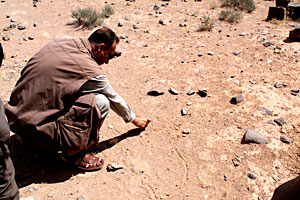 Drawing the site exploration route Drawing the site exploration route 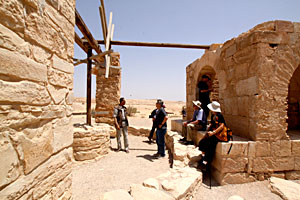 Explaining the caravansarai and its water supply Explaining the caravansarai and its water supply Sharing more knowledge on and around basalt rocks Sharing more knowledge on and around basalt rocks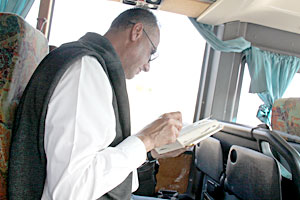 Constant study and preparation Constant study and preparationfor next exciting site visit 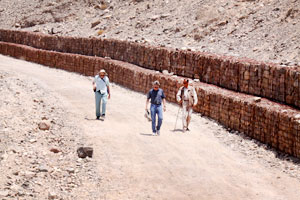 Trekking to new site Trekking to new site | |||
|
||||
